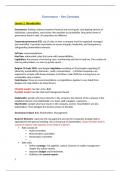Governance – Key Concepts
Lesson 1: Introduction
Governance: finding a balance between financial and social goals, and aligning interest of
individuals, corporations, and society. Also provides accountability. One perfect form of
governance doesn’t exist, all companies are different.
Corporate governance (CG): set of rules on how a company must be organized, managed,
and controlled. It provides mechanism to ensure integrity, leadership, and transparency.
Safeguarding shareholders interests.
Soft law: recommendations
Hard law: enforceable rules that come with responsibilities.
Legislation: the process of anchoring rules, transforming soft law in hard law. The creation of
laws by policymakers, ex: Law on gender quota, …
Belgian CG Code 2020: new Belgian legislation consisting of 10 principles regarding CG
(diversity, sustainability, disclosure , audit, remuneration, …) all listed companies are
expected to comply with these principles at all times. Code 2020 has a strong focus on
sustainable value creation.
Code Buysse: these are recommendations, no legislations. Applies to non-listed firms
(Belgian CG Code 2020 is for listed firms!).
Monistic model: one-tier, only a BoD
Dualistic model: two-tier, BoD and Management board
Stakeholder: people who have interests in the company. the interest of the company is the
weighted interest of all stakeholders. Ex: bank, staff, suppliers, customers, …
Shareholder: people who have shares in the company, owners. Shareholders are also
stakeholders. They delegate the decision power to the BoD.
Governance tripod: BoD, Shareholders, Management
Board of Directors: supervise the management and set the companies strategy. BoD is
appointed by the general meeting, this is the group of shareholders. (Does the BoD need to
consist of experts with expertise in the field of activity?)
BoD consists of:
Audit committee
Remuneration committee
Nomination committee
…
BoD tasks:
Defines strategy: risk appetite, culture, however in reality management
shapes the culture mostly.
Approves budget and investments.
Publishes the annual reports.
1
, Appoints and remunerates management, leadership.
Control function, monitoring: annual report, laws, audit,…
Representing (mostly) the shareholders
Non-executive directors (NED’s): directors with no participation in management. They have
no performance related payments, no bonusses. But can be paid with shares.
Executive directors: CEO for example, active in BoD and management. Can receive
performance bonusses and must hold a minimum of shares.
Nose in, fingers out (NIFO): BoD must govern but not intervene with management activities,
CEO and management must keep some level of freedom to operate.
CEO: bridge between BoD and management, appointed by the BoD. CEO reports to the
board and can be part of the board. CEO runs day-to-day responsibilities given by the board,
captain of the ship and knows what is going on in the company. It is advisable not to appoint
the CEO as chairman of the board, threatens independency. CEO also appoints the members
of the management committee.
Management (committee): responsible for the day-to-day functioning of the company and
implements the strategy of given by the BoD. Management can implicated to control and
advise on risky transactions. Management reports to BoD trough CEO.
Agency issues: when BoD, shareholders and management have other, opposing, interests.
Theranos Case: unethical behavior where CEO lied to investors on the success of its
products. Board consisted of all high-level but incompetent individuals, culture was
oppressive and secretive.
Lesson 2: Governance bodies part 1
Information: board depends on information it gets from the management committee, BoD
must dare to ask challenging questions.
Stakeholder in corporate governance:
Shareholders:
Family shareholder: LT shareholder that act in more emotional manner, a
family council can be held to align the family’s interest and priorities.
Financial institutions: these are closely monitored and regulated with
mandatory board committees: risk, audit, remuneration and nomination
committee! (why are financial institutions more regulated?)
Professional investors: shareholder by choice
- Minority shareholder: looks for profit but cannot control the
company with minor stake (ex: me on Degiro).
- PE shareholder: accesses the board by acquiring enough
shares, reshapes the company and sells of the shares.
2




